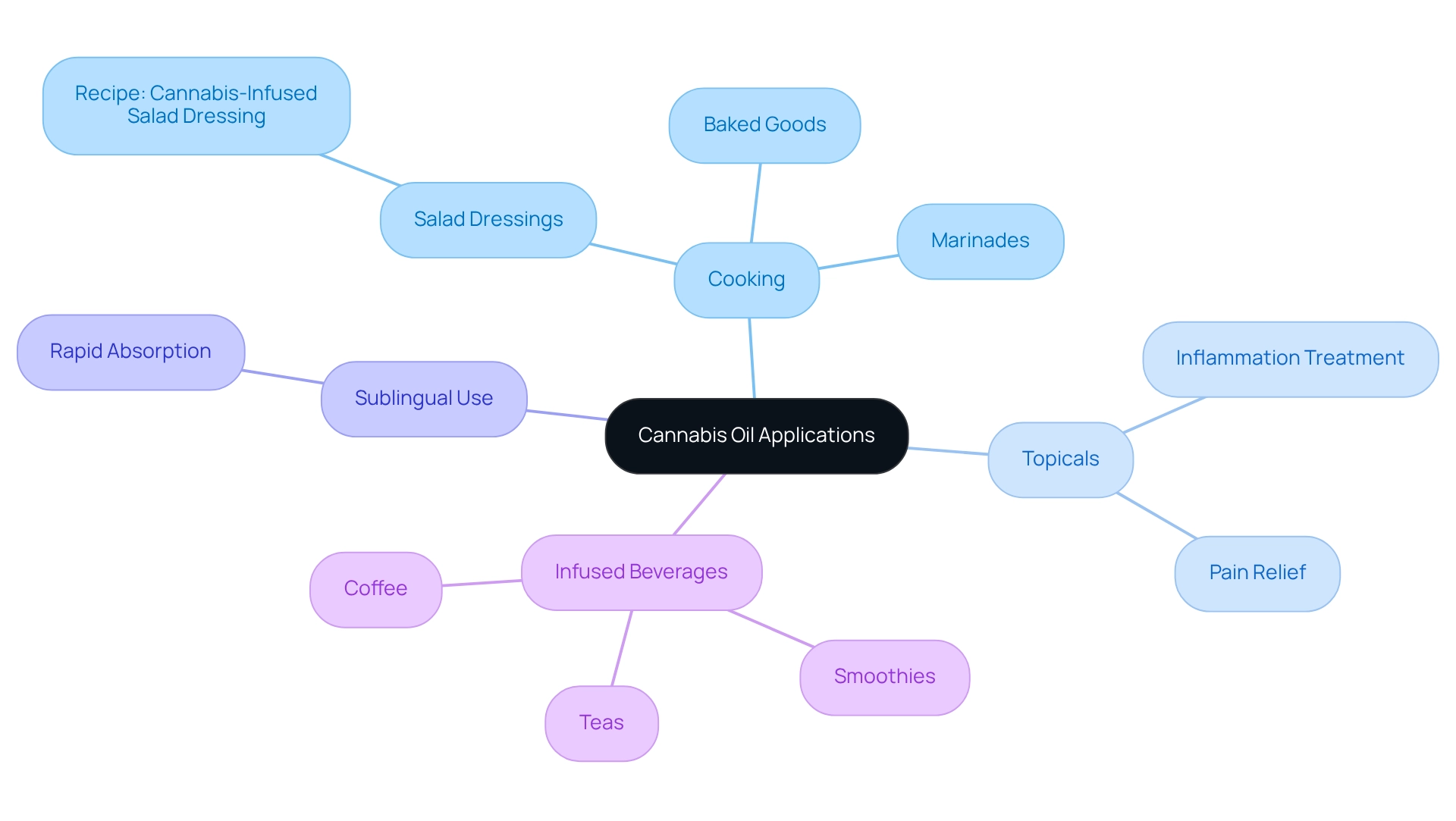How to Make Cannabis Oil: A Step-by-Step Guide for Beginners
by Maya Green · April 2, 2025
Learn how to make cannabis oil with this step-by-step guide for beginners.

Overview
This article serves as a compassionate, step-by-step guide on how to make cannabis oil, addressing essential materials, the infusion process, and best practices for storage and usage.
It’s important to remember that decarboxylation plays a crucial role in activating cannabinoids, which can be a game-changer for those seeking relief.
Many patients are finding therapeutic benefits in cannabis oil, and this growing acceptance reflects a shift toward more informed and careful preparation.
If you’re struggling with chronic pain or anxiety, know that you’re not alone, and with the right approach, you can explore the potential of cannabis oil for your well-being.
Introduction
In recent years, cannabis oil has emerged as a powerful ally in the quest for natural relief from various ailments, especially chronic pain and anxiety. This concentrated extract, rich in cannabinoids like THC and CBD, offers a versatile approach to wellness, appealing to both medical users and culinary enthusiasts alike. As we deepen our understanding of cannabis oil, it becomes crucial to distinguish between its various forms—such as full-spectrum, broad-spectrum, and CBD isolate—especially for those seeking tailored therapeutic benefits.
With growing acceptance and a wealth of research supporting its efficacy, the exploration of cannabis oil promises not only to enhance quality of life but also to revolutionize pain management practices. It’s important to remember that you’re not alone in this journey; many individuals are finding solace in these natural remedies. This article delves into the intricacies of cannabis oil, from its preparation and infusion techniques to practical applications and safety considerations, providing a comprehensive guide for both newcomers and seasoned users. Together, we can navigate this exciting landscape of natural relief and discover the potential benefits that await.
Understanding Cannabis Oil: Definition and Uses
Cannabis oil, a concentrated extract from the hemp plant rich in cannabinoids like THC (tetrahydrocannabinol) and CBD (cannabidiol), is often sought after by those eager to learn how to make it. This versatile oil is utilized for various purposes, particularly pain relief and anxiety reduction, making it a popular choice among chronic pain patients. It’s essential to grasp the distinctions between the different types of marijuana oil to choose the most suitable product for your personal needs.
The main categories consist of:
- Full-Spectrum: Contains all cannabinoids present in the hemp plant, including trace amounts of THC, which may enhance therapeutic effects through the entourage effect.
- Broad-Spectrum: Similar to full-spectrum but without THC, offering a variety of cannabinoids while minimizing psychoactive effects.
- CBD Isolate: Pure CBD without other cannabinoids, ideal for those seeking the advantages of CBD without any THC.
Hemp oil can be incorporated into cooking, applied topically for localized relief, or taken sublingually for quicker absorption into the bloodstream. Recent studies have highlighted the prevalence of hemp oil use among chronic pain patients, with many reporting significant improvements in their quality of life. For instance, a study focusing on chronic pain patients revealed that after three months of medical marijuana treatment, participants experienced notable enhancements in sleep quality and reductions in mood disturbances, with quality of life scores increasing from 0.54 to 0.67.
Moreover, expert opinions emphasize the potential benefits of marijuana oil for pain relief, and many health professionals advocate for its use as a complementary treatment. Robby Brumberg, a previous health writer, observes that marijuana oil can play a significant role in enhancing patient outcomes. While additional research is needed to completely comprehend the efficacy of medicinal marijuana in pain management, current statistics show an increasing acceptance and use of hemp oil among patients seeking relief from chronic pain and anxiety.
As the landscape of marijuana research evolves, the insights gained from ongoing studies will continue to inform best practices for using oil effectively. At Leafy DOC, we are dedicated to assisting patients in discovering the transformative health advantages of medical marijuana, including its uses for conditions like epilepsy and cancer support. Remember, you are not alone on this journey; seeking knowledge and support is a vital step towards finding relief.
Essential Materials and Equipment for Making Cannabis Oil
Creating cannabis oil, especially cannabis-infused olive oil, can be a rewarding experience. To help you along this journey, it’s essential to gather the right materials and equipment:
- Cannabis Flower: Choose high-quality, dried cannabis flower to ensure your final product is potent. The strain you select can influence the oil’s effects; for instance, THC-infused olive oil is ideal for relaxation and pain relief, while CBD-infused olive oil is perfect for medicinal use without the high.
- Extra Virgin Olive Oil: This is the best choice for infusion due to its high fat content, which helps cannabinoids bind effectively. Its rich flavor complements both sweet and savory dishes, and it’s packed with healthy fats and antioxidants that promote heart health and reduce inflammation.
- Grinder: A dependable grinder is crucial for breaking down the herb into smaller, uniform pieces, which facilitates better infusion.
- Double Boiler or Slow Cooker: These tools provide gentle heating, essential for effectively combining the oil and plant material without degrading the cannabinoids. A slow cooker can maintain a steady temperature, ensuring a smooth infusion process.
- Cheesecloth or Fine Strainer: After infusing, use cheesecloth or a fine strainer to separate the oil from the plant material, ensuring a smooth final product.
- Glass Jar: Store your finished oil in a glass jar to maintain its potency and freshness. Dark glass bottles are recommended to protect the oil from light degradation.
- Baking Sheet: Utilize a baking sheet for decarboxylating the plant material in the oven, a critical step that activates the cannabinoids for maximum effect. Preheat your oven to 240°F and bake the herb for 30 to 40 minutes.
Before you begin the infusion process, it’s important to understand how to make cannabis oil and ensure that all these items are prepared and within reach. This preparation not only streamlines the process but also enhances the quality of the oil produced. Understanding the average expenses linked to these materials can assist you in budgeting; typically, the total outlay for high-quality ingredients varies from $50 to $100, depending on the selected carrier oil and plant strain.
In terms of financial context, it’s noteworthy that the revenue for marijuana oil production is projected at $4,005,450, with direct costs estimated at $1,852,005. This information can help you budget effectively for your oil production. Additionally, Kenneth Morrow, an expert in the field, reminds us, “The point from these two misadventures is this: Don’t over-complicate your extraction process,” a crucial reminder for beginners.
While ethanol alcohol extraction can be a viable method, it also produces a crude extract that requires refinement, with apparatus costs ranging from $5,000 to millions, necessitating a legally compliant laboratory. Insights from case studies on equipment used for marijuana oil extraction highlight the importance of selecting the right tools to avoid unexpected operational costs and ensure a smooth production process. Proper planning for maintenance and operational costs can prevent unexpected financial burdens and downtime, ensuring that your extraction operations run smoothly and efficiently.
The Decarboxylation Process: Activating Your Cannabis
Decarboxylation is a crucial process that activates the cannabinoids in marijuana, transforming THCA (tetrahydrocannabinolic acid) into THC, the compound responsible for psychoactive sensations, and CBDA (cannabidiolic acid) into CBD. This activation is essential for creating effective marijuana oil and other infused products, like marijuana-infused honey, which may have minimal effects if not decarboxylated. You might find it helpful to follow this step-by-step guide to decarboxylating your marijuana:
- Preheat your oven to 240°F (115°C).
- Break the marijuana into smaller pieces and spread it evenly on a baking sheet. Bake for 30-40 minutes, stirring occasionally to ensure even heating.
- Allow the decarbed plant material to cool before incorporating it into your oil infusion.
The significance of decarboxylation cannot be overstated. Recent research highlights that this process significantly impacts the potency of cannabis-derived products. For instance, studies have determined optimal temperature and time conditions for complete decarboxylation, which are vital for maximizing cannabinoid activation.
One study utilized ultra-high performance supercritical fluid chromatography to analyze the decarboxylation of acidic cannabinoids, providing insights into effective methods for cannabinoid conversion. Moreover, understanding the energy barriers involved in the decarboxylation of compounds like CBDA is essential. Research indicates that the first transition state for CBDA has an energy barrier of 317.683 kJ/mol, underscoring the complexities of cannabinoid activation. Additionally, a larger quantity of plant material in a reactor leads to a slower process of CBDA conversion, emphasizing the importance of the amount of herb used in the decarboxylation process.
This knowledge is invaluable for anyone aiming to understand how to make cannabis oil at home. Real-world examples of decarboxylation techniques illustrate the effectiveness of this process. Many enthusiasts have reported that proper decarboxylation not only enhances the potency of their oil but also improves the overall flavor and therapeutic benefits. By mastering this technique, you can learn how to create cannabis oil that is both effective and enjoyable.
Furthermore, it’s essential for healthcare providers to consider optimal dosing schedules and safety issues regarding marijuana use, especially for chronic pain patients. At Leafy DOC, we emphasize the importance of proper decarboxylation to maximize the advantages of your products. Remember, taking the time to understand and implement this process can greatly enhance your experience with cannabis oil.
Infusing Cannabis with Oil: Step-by-Step Instructions
To infuse marijuana with oil effectively, follow these caring steps:
- Combine Ingredients: Begin by decarboxylating your herb to activate its beneficial compounds. In a double boiler, combine the decarboxylated herb with your chosen carrier oil at a 1:1 ratio. For example, using 1 cup of marijuana to 1 cup of oil will yield an optimal infusion. If you’re looking to create a smaller batch, consider using 1/4 cup (60 mL) of infused coconut oil, which provides a total of 525 mg THC in the batch. This can help you gauge your dosage, ensuring you find what works best for you.
- Heat the Mixture: Set the double boiler on low heat and allow the mixture to warm for 2-3 hours. Stir occasionally to promote even distribution. It’s important to keep the temperature below 200°F (93°C) to prevent burning the plant material, which could diminish its potency.
- Monitor Consistency: As the infusion progresses, you may notice the oil taking on a greenish hue and a fragrant aroma. This indicates that the cannabinoids are effectively infusing into the oil, enhancing its therapeutic properties. A recent study published in Clinical Therapeutics discovered that 91% of military veterans who consult providers for medical marijuana reported that it has improved their quality of life. This highlights the potential benefits of marijuana-infused products for individuals dealing with chronic pain, including veterans with PTSD and cancer patients undergoing treatment.
- Remove from Heat: Once the infusion is complete, carefully remove the mixture from heat. Allow it to cool slightly before straining through a fine mesh strainer or cheesecloth to separate the plant material from the infused oil. This step ensures a seamless final product, ready for use in your favorite recipes.
By following these steps, you will learn how to make cannabis oil, a powerful ingredient for homemade edibles. This allows you to explore the advantages of marijuana in a tasty and controllable way. As the marijuana market is projected to reach $45.3 billion in revenue by 2025, the relevance and acceptance of marijuana products, including infused oils from Leafy DOC, continue to grow. This reflects a shift towards safer alternatives for pain management, and you are taking a positive step towards your well-being.
Straining Your Cannabis Oil: Tips for a Clean Finish
To strain your cannabis oil effectively and achieve a clean finish, follow these compassionate steps:
- Prepare Your Strainer: Begin by using a cheesecloth or a fine mesh strainer. Place it over a clean glass jar or bowl to catch the oil, ensuring you have a tidy workspace.
- Pour the Mixture: Carefully pour the infused oil through the strainer. This process allows the liquid to flow through while trapping the plant material, ensuring a smoother final product that you can feel good about.
- Squeeze for Extra Oil: If you’re using cheesecloth, gather the edges and twist to squeeze out as much oil as possible from the plant material. This step is crucial; studies indicate that effective straining can significantly enhance cannabinoid yield, with some methods yielding up to 49% more THC converted from CBD.
- Discard the Residue: Dispose of the leftover plant material responsibly, maintaining a clean workspace. Your marijuana oil is now ready for use!
By employing these best practices on how to make cannabis oil, you can ensure that your oil is not only potent but also free from impurities, enhancing its overall quality. Remember, the potency of your olive oil infused with marijuana will depend on the kind of marijuana used and the quality of the olive oil. Extra virgin olive oil is recommended for its rich taste and healthy fats, which can contribute to a more potent infusion.
However, light or regular olive oil can also be used, though the flavor may not be as strong. It’s important to remember that understanding how to make cannabis oil involves recognizing that the method of extraction and straining can greatly influence the cannabinoid profile. As highlighted in the case study “Impact of Extraction Method on Cannabinoid Composition,” different extraction methods can significantly affect cannabinoid profiles. Choose your techniques wisely to tailor the oil to your desired effects.
Furthermore, specialist Nick Jikomes emphasizes the significance of appropriate methodology in attaining optimal outcomes in oil extraction from the plant. You may find that with patience and care, you can create a product that truly meets your needs.
How to Use Cannabis Oil: Recipes and Applications
Cannabis oil offers a versatile range of applications that can enhance both culinary experiences and personal wellness, especially when combined with cannabis-infused honey. You may find joy in discovering popular ways to incorporate cannabis oil and cannabis-infused honey into your routine:
- Cooking: Consider substituting cannabis oil or cannabis-infused honey for regular oil or sweeteners in various recipes, such as salad dressings, marinades, or baked goods. This not only enhances taste but also enriches your meals with the healing properties of marijuana. For instance, cannabis-infused honey can be utilized in baked items or as a sweetener in sauces, offering both flavor and health benefits.
- Topicals: If you’re seeking localized relief from pain or inflammation, applying marijuana oil directly to the skin might be beneficial. This approach is particularly advantageous for individuals pursuing non-intoxicating alternatives, as it enables focused treatment without mental impacts. In states with medical programs, topicals can serve as a gateway for patients looking to experience the advantages of marijuana without any psychological effects.
- Sublingual Use: For those who prefer rapid absorption into the bloodstream, placing a few drops of hemp oil under your tongue can be effective. This method is favored for its quick onset of effects, making it ideal for managing sudden discomfort.
- Infused Beverages: You can enhance your drinks by adding marijuana oil or marijuana-infused honey to smoothies, teas, or coffee. This creates a relaxing beverage that can be enjoyed at any time of day. Stirring in cannabis-infused honey not only adds flavor but also therapeutic benefits.
Sample Recipe: Cannabis-Infused Salad Dressing
To create a delicious and healthful salad dressing, try this simple recipe:
- 1/4 cup cannabis oil or cannabis-infused honey
- 1/4 cup balsamic vinegar
- 1 teaspoon Dijon mustard
- Salt and pepper to taste
Combine all ingredients in a jar, shake well, and drizzle over your favorite salad for a delightful twist.
Current trends indicate a growing interest in hemp oil, particularly among consumers seeking non-intoxicating options. A recent survey revealed that 36% of adult women have used hemp-based topicals, highlighting the appeal of these products for localized relief. As more individuals explore the culinary uses of hemp oil and honey, innovative recipes and applications continue to emerge, making it an exciting ingredient for both novice and experienced cooks alike.
As mentioned by Angelo A Izzo from the University of Naples Federico II, “These products are designed to provide health advantages alongside their fundamental nutritional value and typically include components that are considered generally recognized as safe (GRAS) in the United States and beyond.”
The evolving landscape of marijuana use is further illustrated by Slovenia’s recent approval of home cultivation, reflecting a growing acceptance of the substance among the population. With Leafy Doc’s emphasis on swift approvals and thorough assistance, patients can easily access oil and explore its many advantages.
Storing Your Cannabis Oil: Best Practices for Longevity
To store your cannabis oil effectively and ensure its longevity, consider these best practices that can make a difference in your experience:
- Use Dark Glass Containers: Choosing dark glass bottles is essential. They protect your oil from light exposure, which can significantly degrade its quality over time.
- Keep in a Cool, Dark Place: Storing the oil in a cool, dark cupboard or, ideally, in the refrigerator helps maintain its potency. This minimizes temperature fluctuations and light exposure, which can be detrimental.
- Seal Tightly: It’s important to ensure that the container is sealed tightly. Preventing air exposure is crucial, as oxidation can degrade cannabinoids, diminishing the oil’s effectiveness.
- Check for Freshness: Regularly inspecting the oil for changes in color or smell is a wise practice. These changes may indicate spoilage. When stored properly, marijuana oil can maintain its quality for up to a year.
Recent studies have shown that the stability of CBD is influenced by various factors, including temperature, humidity, oxygen access, and light exposure. Notably, significant degradation occurs under higher temperatures and open conditions. For instance, a study indicated that oil samples stored at 40 °C ± 2 °C and 75% relative humidity in open vials experienced a statistically significant decrease of approximately 4.5% in quality.
This highlights the importance of following appropriate storage methods to maintain the potency of your oil. As mentioned by the Ministry of the Interior of the Czech Republic, “This research was funded by Ministry of the Interior of the Czech Republic, grant number MV0/VI20172020056,” underscoring the significance of these findings in the context of marijuana oil storage.
By adhering to these guidelines, you can ensure that your oil remains effective and safe for use. This is especially crucial for those who rely on the therapeutic advantages of medical marijuana, such as chronic pain patients. Leafy DOC facilitates access to medical marijuana through telehealth services, ensuring that patients can obtain high-quality products while also providing guidance on best practices for storage and use.
Furthermore, medical marijuana has been shown to offer transformative health benefits for conditions like anxiety, epilepsy, and cancer support. It truly is a valuable resource for those in need, and following these storage tips can help you make the most of it.
Safety First: Understanding Risks and Side Effects of Cannabis Oil
While cannabis oil can offer numerous benefits, it’s essential to understand the potential risks and side effects associated with its use.
- Common Side Effects: You might notice side effects such as dry mouth, dizziness, fatigue, and changes in appetite. These reactions can vary in strength and duration, highlighting the importance of paying attention to how your body responds to hemp oil. If you’re using medicinal marijuana for persistent pain relief, drowsiness may occur, but often, these effects can be managed effectively with the guidance of a healthcare professional.
- Drug Interactions: Cannabis oil may interact with various medications, leading to unintended consequences. It’s advisable to consult with a healthcare provider before learning how to make cannabis oil and incorporating it into your routine, especially if you’re currently taking other medications. This step is crucial, as combining treatments can enhance the overall effectiveness of managing your symptoms.
- Dosage Caution: Finding the right dosage is vital for maximizing benefits while minimizing adverse reactions. If you’re new to cannabis oil, starting with a small dose and gradually increasing it can help you discover what works best for your individual needs. Research has shown that the impact of hemp oil can differ significantly from person to person. For instance, studies have explored how CBD affects hormone synthesis, particularly progesterone and testosterone metabolism in rats, indicating that high concentrations of CBD can inhibit progesterone 17-hydroxylase, which may influence steroid synthesis.
- Legal Considerations: Before purchasing or using marijuana oil, please ensure it is legal in your state or country. Regulations regarding marijuana products can vary widely, and being informed about local laws is crucial for safe usage.
Recent research has shed light on the safety and implications of marijuana oil. For instance, studies have indicated that high concentrations of CBD can inhibit certain hormone syntheses, which may be significant for users. Current inquiries funded by organizations like NIDA are examining the health impacts of marijuana, including its potential interactions with other substances.
Importantly, reported drug use among teenagers has remained below pre-pandemic levels in 2023, indicating changing patterns in marijuana consumption.
As noted by Iffland K and Grotenhermen F, “An update on safety and side effects of cannabidiol: a review of clinical data and relevant animal studies,” it’s vital to approach hemp oil use with caution and awareness of the associated risks. In summary, while learning how to make cannabis oil can be a valuable addition to your wellness routine, it’s essential to stay informed and consult with healthcare professionals to navigate the complexities of hemp oil safely and effectively. Leafy DOC is dedicated to providing fast approvals and comprehensive support, ensuring that patients are educated about how to make cannabis oil safely.
Conclusion
Cannabis oil has emerged as a versatile and effective option for those seeking natural relief from chronic pain and anxiety. By understanding the different types of cannabis oil—full-spectrum, broad-spectrum, and CBD isolate—you can select the most appropriate product to meet your individual needs. The preparation process, including essential steps like decarboxylation and infusion, is crucial for maximizing the therapeutic benefits of cannabinoids, ensuring that the final product is both potent and effective.
Incorporating cannabis oil into your daily routine can take various forms, from culinary applications to topical treatments and sublingual use. Each method offers unique advantages, allowing you to tailor your experience based on personal preferences and desired outcomes. As the acceptance and research surrounding cannabis continue to grow, the potential for cannabis oil to enhance your quality of life becomes increasingly evident.
However, it’s important to approach cannabis oil use with caution, particularly regarding dosage and potential interactions with other medications. Consulting healthcare professionals can provide invaluable guidance, ensuring a safe and beneficial experience. By adhering to best practices for storage and usage, cannabis oil can remain a reliable resource for those looking to improve their well-being through natural remedies. As the landscape of cannabis research evolves, continued exploration of its benefits promises to revolutionize pain management and overall health support.
Frequently Asked Questions
What is cannabis oil and what are its primary uses?
Cannabis oil is a concentrated extract from the hemp plant that is rich in cannabinoids, such as THC and CBD. It is commonly used for pain relief and anxiety reduction, making it particularly popular among chronic pain patients.
What are the different types of cannabis oil?
The main types of cannabis oil are: Full-Spectrum: Contains all cannabinoids from the hemp plant, including trace amounts of THC, which may enhance therapeutic effects. Broad-Spectrum: Similar to full-spectrum but without THC, providing various cannabinoids while minimizing psychoactive effects. CBD Isolate: Pure CBD without other cannabinoids, ideal for those wanting the benefits of CBD without THC.
How can hemp oil be used?
Hemp oil can be used in cooking, applied topically for localized relief, or taken sublingually for quicker absorption into the bloodstream.
What have studies shown about the effects of hemp oil on chronic pain patients?
Studies indicate that many chronic pain patients using hemp oil report significant improvements in their quality of life, including better sleep quality and reduced mood disturbances.
What do health professionals say about the use of marijuana oil?
Many health professionals advocate for the use of marijuana oil as a complementary treatment for pain relief, noting its potential to enhance patient outcomes.
What materials are needed to create cannabis-infused olive oil?
The materials needed include: High-quality, dried cannabis flower; Extra virgin olive oil; Grinder; Double boiler or slow cooker; Cheesecloth or fine strainer; Glass jar for storage; Baking sheet for decarboxylating the plant material.
What is the process for decarboxylating cannabis?
To decarboxylate cannabis, preheat the oven to 240°F and bake the herb on a baking sheet for 30 to 40 minutes, which activates the cannabinoids for maximum effect.
What is the estimated cost of materials for making cannabis oil?
The total cost for high-quality ingredients typically ranges from $50 to $100, depending on the selected carrier oil and cannabis strain.
What financial considerations should be taken into account for marijuana oil production?
The projected revenue for marijuana oil production is approximately $4,005,450, with direct costs estimated at $1,852,005. Proper budgeting for ingredients and equipment is essential to avoid unexpected costs.
What advice is given for beginners in the extraction process?
Beginners are advised not to over-complicate the extraction process, and to focus on selecting the right tools to ensure smooth production and avoid unexpected operational costs.
Last Updated: April 21, 2025
Get Your Medical Card
Connect with a licensed physician online in minutes

Like This Article?
Share with your friends
Table of Contents
Keep Reading

How to Use a Weed Calculator: A Step-by-Step Guide for Accurate Dosing
Discover how to effectively use a weed calculator for precise dosing and enhanced cannabis experiences.

Microdosing Cannabis For Pain Management: A Gentle Approach
Struggling with pain? Explore the gentle and effective relief of cannabis microdosing for pain management. Discover if this approach is right for you today!

Top 5 Weed Coconut Oil Recipes for Pain Relief and Wellness
Discover the benefits of weed coconut oil recipes for pain relief and wellness in your cooking.






